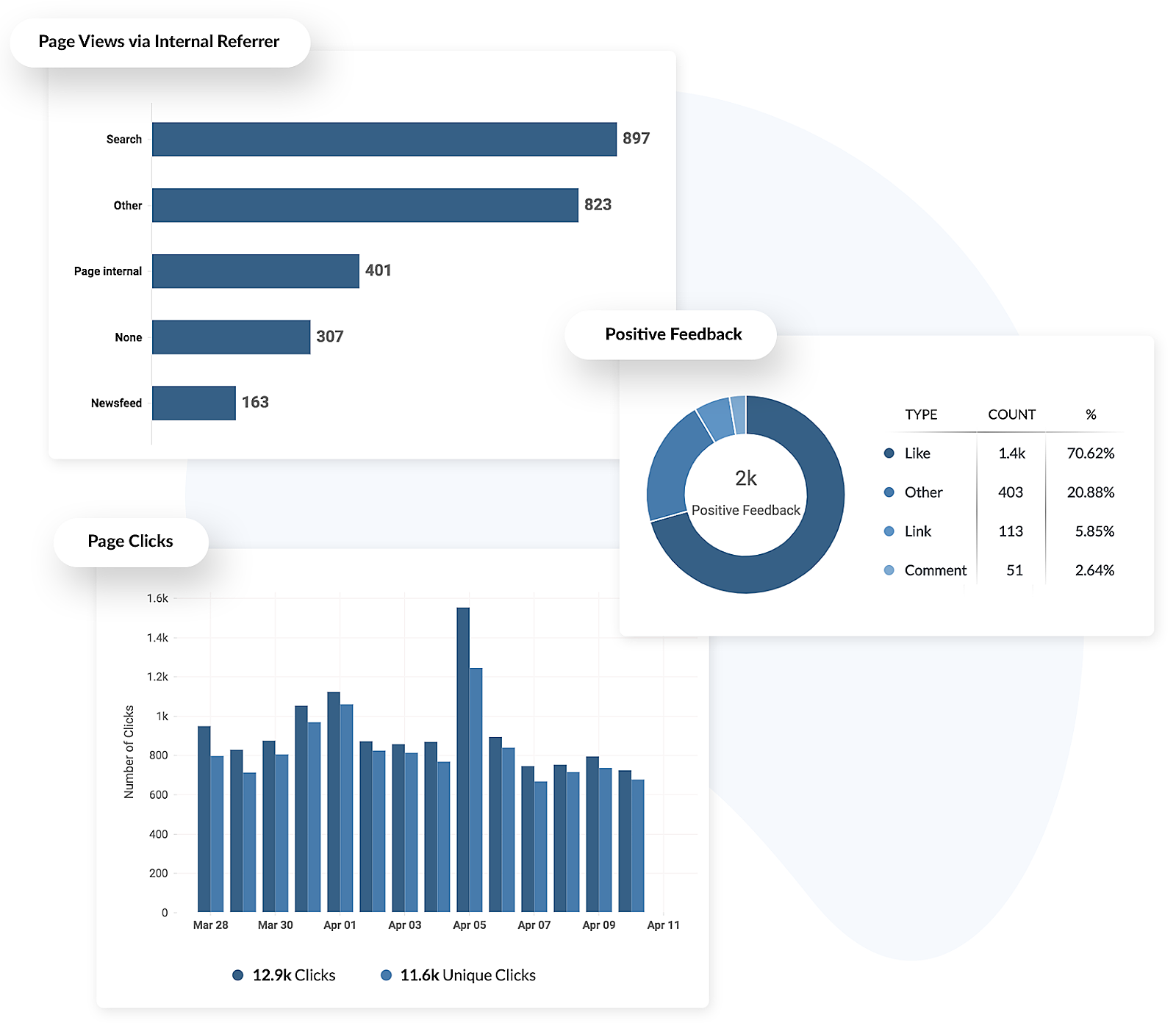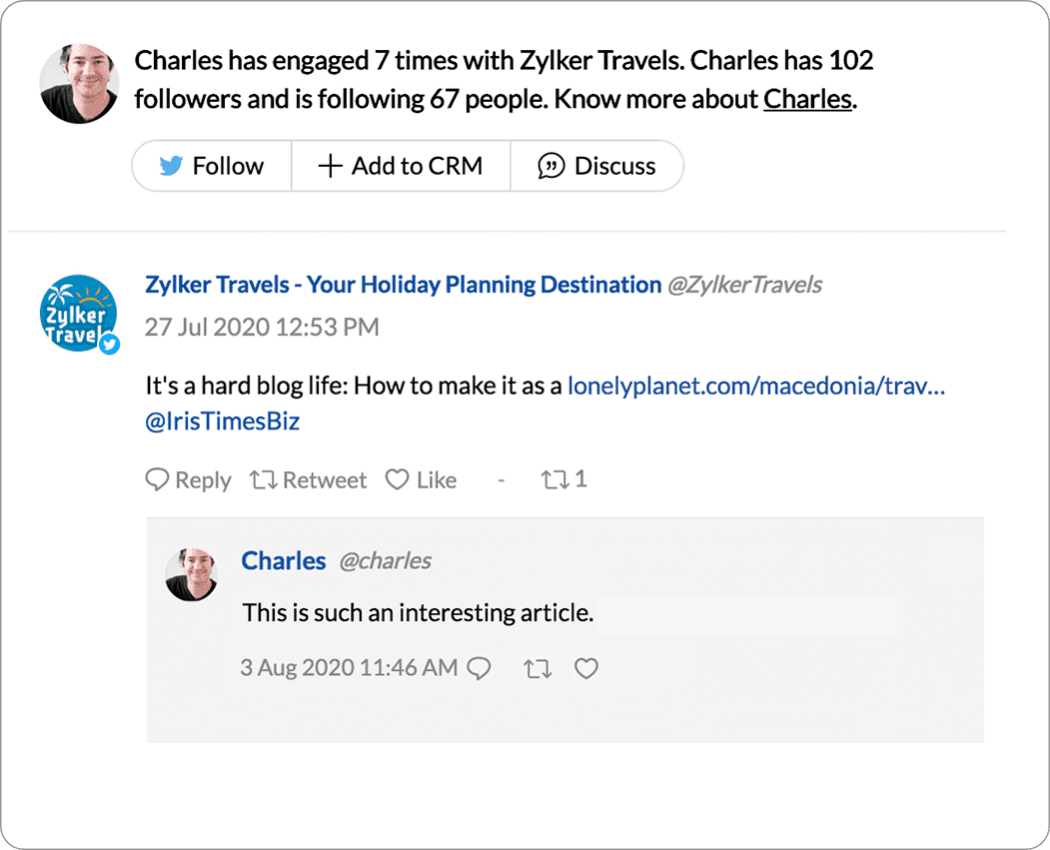30+ social media metrics you should be measuring as a startup
- Last Updated : July 10, 2025
- 2.6K Views
- 12 Min Read

This is a guest post from Meenakshi Nautiyal aka Meenz is a Growth Marketer for Nextiva. She's passionate about everything SaaS, start-ups, and SEO. She has a successful track record of 10+ years scaling organic traffic and inbound leads for various startups. Bibliophile and coffee-lover who dives into art therapy during her free time.

If you’re a startup founder, social media marketing metrics probably aren’t your thing.
You may be keeping mental notes whenever a post racks up likes and shares. You may even be using a spreadsheet to track these stats manually. But you’re probably not utilizing your social media data to its full potential.
And that’s a huge mistake.
Social media is a wealth of untapped potential for startups. You can gain boatloads of traffic to your website, interact with brand advocates, raise your reputation, and even make money on these channels.
But you can only score these perks with a social media marketing strategy that works. And you can’t know if yours is effective unless you’re tracking the numbers.
So we’re highlighting 30+ social media marketing metrics to keep on your radar. You’ll learn why they’re important, how to measure them, and more useful intel for your quest to greatness.
Here’s an overview of what’s in store:
What are social media metrics?
Where do you find social media metrics?
Why are social media metrics important for your startup?
30+ social media marketing metrics to track as a startup
Let’s begin with a quick primer:
What are social media metrics?
Social media metrics are key performance indicators (KPIs) that show how effective your social media efforts are.
In this case, KPIs might be anything from how many likes your latest Instagram post scored to how many new Twitter followers you earned last quarter.
Where do you find social media metrics?
There are three ways to access your startup’s social media metrics:
Social media platform-native analytics
Each social media channel offers creators an analytics dashboard. Twitter has Twitter Analytics, Pinterest has Pinterest Analytics, and so on. These reports spotlight your company’s presence on each platform.
Just log in to your dashboard, and you’ll find all your data organized into graphs, charts, stats, and more. You can filter data and create custom reports to snag the insight you’re seeking.
Google Analytics
Google Analytics can also be your friend here.
Your dashboard can track and monitor traffic to your website from all your social media channels (under Acquisition > Traffic). It can also show whether that traffic is converting according to your conversion goals (under Acquisition > Social > Conversions).
It even helps refine your audience’s demographics by pointing out stats like where your audience lives or what devices they access your content from.
Third-party social media management platforms
Did you know the average social media user visits 6.7 different social networks per month?
That means you can't stick to one channel—you need to diversify your social presence, which will obviously take more time.
With a social media management platform like Zoho Social, you can schedule unlimited posts, monitor metrics that matter most to your business, and create custom reports to analyze your social media performance across all your channels.

Zoho makes social media metrics a piece of cake, allowing you to deep dive into what’s working best for your brand without any of the stress.
Why are social media metrics important for your startup?
Social media marketing metrics highlight the direct impact of your time, money, and effort on achieving your social media goals.
Whether these goals include boosting community engagement or lead generation, tracking your social metrics gives you a game plan to victory. You and your team can then:
Stop spinning your wheels and work smarter
If you don’t know what’s working (or failing), you’ll never drive real progress. See the data for yourself, and you’ll know exactly which areas need an improvement plan and which actions should be replicated for the win.
You can further refine and tweak processes to learn what works well on each platform. You’ll be able to create more nuanced strategies to maximize your outreach efforts.
Make more-informed, data-driven decisions
Quit relying on gut instincts and wasting valuable time and resources. When you test variables and monitor your social media metrics, you’ll have concrete data about how your target audience responds.
You’ll learn what drives the most traffic, engagement, revenue, etc. You can also see what doesn’t resonate with your audience. Then you can intelligently invest more time and money in the right platforms or campaigns.
Quickly spot industry trends and innovate based on actual feedback
Want to take action on emerging trends before your competitors? You can use social media to hear what people are interested in, talking about, and engaging with most.
Keep your ear to your social channels, and you’ll receive helpful feedback and suggestions to iterate new and improved versions of your products/services.
Improve your customer experience
Your customer journey starts the moment someone first hears about or interacts with your brand. This initial touchpoint is increasingly occurring on social media.
Recent social media marketing stats show 71% of consumers who had a positive experience with a brand on social media are likely to recommend that brand to their friends and family.
How you interact with customers plays a significant role in the probability of a positive experience. A recent customer service study found that 82% of customers have a positive experience when interacting with a brand or a company over live chat vs. 44% of customers have a positive experience over a call.
So improving your social listening and metrics like your response rate will create happier customers and expand your reach.
All these reasons prove measuring your social media marketing metrics is worth your time and energy.
With thousands of available social media KPIs to track, you could spend all day deep in your data. You definitely don’t have time for that, so you’ll need to decide the most essential metrics to track based on your social media goals.
30+ social media marketing metrics to track as a startup
Now that you know why tracking social media metrics is so vital, let’s look at a list of the top ones your startup should begin monitoring.
Setting social media goals gives you and your team specific areas to focus on. This helps define what success looks like and how to meet your expectations.
Figure out your goals, then you’ll know which specific social media KPIs you’ll need to track. Once you have your baseline, monitoring the data going forward will highlight whether you’re headed in the right direction or need to rethink your strategy.
We organized this list of social media marketing metrics to track based on the most common social media startup goals:
Brand awareness
A staggering 54% of people use social media to research products [*], so these platforms make the ideal location to introduce your brand to your target audience.
These social media metrics reveal how popular your brand is:
Impressions: the number of times your posts or ads were on screen. Basically, how many people saw your posts in their feed or while scrolling (even if they didn’t interact with them).
Mentions, shares, retweets, pins, regrams, etc. People performing these actions are engaging with your brand and telling others in their network about you.
Posts reach: how far your content spreads online. Higher mentions/shares/retweets/etc. usually correspond with greater post reach.
Follower count: the total number of fans and followers on your social media channels.
Audience growth rate: or how much your follower count grows (or shrinks) in a given timeframe. How quickly are you adding new followers every day, month, quarter, etc.?
Track these metrics, and you’ll learn whether you’re actually connecting with your audience. Improve them, and you’ll have new followers flocking to your accounts and more people talking about your brand.
Brand engagement
Brand engagement is one of the biggest reasons marketers use social media. The algorithms on these channels prioritize engaging content, believing users will be more interested in what others find interesting.
This not only boosts your posts to the top of their feeds but also increases brand perception.
Use these social media metrics to gauge brand engagement:
Applause rate (likes, shares, thumbs up, and comments): describes the level of interaction and engagement your posts garner (and whether people like what you’re posting). How many of these does your company receive per social post?
Mentions and replies: the number of times people mention or reply to your posts indicates their interest and willingness to share your posts with their network.
Social Share of Voice (SOV): measures your share of the social media market against your competitors. If people share your content or branded hashtags more than the average, you’ll emerge as a leader in your industry.
Average engagement rate (AER): the total number of interactions (likes, shares, comments, etc.) on your posts in a given time frame divided by your number of followers.
One note on average engagement rates:
Though it’s an excellent marker of how well your social media efforts are faring, these averages do vary by platform. For example, the average engagement rate on Facebook was 0.27% in 2020, whereas it was 0.07% on Twitter and 1.16% on Instagram [*].
Traffic
It’s a smart idea for startups to use social media to drive traffic to their websites. Here’s where newcomers can learn more about your brand, sign up for your newsletters, or even become a customer.
To see how well your team accomplishes this task, keep an eye on these social media metrics:
Social media traffic: how many website visitors come from your social media channels.
Percentage of overall traffic: the share of your overall website traffic coming from social media.
Clicks on social media posts: measures whether people are interacting with your social posts by clicking the links you’re sharing. People click links to learn more, but if your calls to action (CTAs) are not compelling enough, they’ll just keep scrolling.
Bounce rate: typically the number of people who land on your pages and quickly navigate away. If they’re coming from social media, this means they clicked on a link in one of your posts but didn’t spend very long on the page they got to.
Low traffic and high bounce rates mean your messaging, CTAs, or content may not be interesting enough to connect with your audience.
Lead generation
There are 3.78 billion social media users worldwide now, making social media one of the best outlets for lead generation, especially if you’re a SaaS startup or have a long sales process [*].
In this case, we’re defining leads as anyone who shares personal information with your brand online. This may include their name, email address, phone number, etc.
Track social media metrics like these if lead gen is your goal:
Leads from posts: how many new leads your social media posts generate across each platform.
Signups from social media: this includes the number of new people who navigated from social media to your website and traded their personal information to sign up for your newsletter, a free trial subscription, gated content, etc.
Contest/event participation: this number shows how many people gave you their personal information in exchange for a contest entry or an event invite (like a free webinar or demo).
Conversion rate: a conversion can be defined as any action you wish your audience to take. This includes downloading an ebook or whitepaper, signing up for your newsletter, scheduling a call, etc.
Your conversion rate is a direct correlation of how valuable your audience finds your offer. To determine the quality of leads your social posts bring in, take the number of leads from posts and divide it by your total number of page visitors.
Your social posts welcome leads to the top of your funnel. Then your engagement moves them further along until they become customers. So each metric here shows whether you’re using the right social platforms and enticing people with valuable content.
Community interaction
Building a community around your brand helps boost your credibility and positions your company as a trusted industry leader. Here’s where your team can have real-time conversations with followers and customers, answering questions or discussing the latest news and trends.
To see your community outreach, watch these metrics:
Facebook Groups: How many members does your FB group have? How quickly are you adding new members? How many unique posts, likes, and comments do you bank each day, week, month, etc.?
Twitter Chats: How many people participate in your scheduled discussions? How many tweets does each user contribute to the conversation? How many users are utilizing your special branded hashtag? How quickly are these numbers growing?
Slack community: Slack isn’t just an internal messaging app for your team. You can create an exclusive community for people to communicate with your brand. See how many daily active users you get to join your community, and keep improving this metric.
You should set unique goals for your communities that may differ from your regular social media goals.
Revenue
Social media is a viable revenue stream for companies of all sizes, from running paid ads to selling products directly from your chosen platform. However, startups can be especially vulnerable to ad spends that exceed revenue coming in from these channels.
Use these social media metrics to ensure that doesn’t happen and that you’re actually turning followers into customers:
Signups: How many users are signing up for your service from social media? How many have started since your ad campaigns launched?
Website conversions/sales revenue from social media: How much are your social media conversions adding to your bottom line per platform?
Revenue from ads. How much money are you bringing in from your ads? What percentage of your total sales does each platform account for?
Cost per engagement (CPE): the amount of money you’re spending on ads that your audience interacts with. You can use this metric to see whether your influencer spending is paying off.
Customer acquisition costs (CAC): measures the amount of money you spend just to gain one customer. If you’re spending more on ads than you’re bringing in, your CAC is too high.
Watch these stats to keep your team’s spending above water and make sure you’re spending more on social platforms that deliver a higher return on your investment (ROI).
Social media customer support
Providing stellar customer support through your social media channels isn’t just good business advice—it’s the wave of the future. More organizations are migrating to an omnichannel contact center because stats prove:
79% of consumers expect brands to respond within a day of reaching out over social media. Bad news? Average brand response rates are lower than 25% [*].
54% of people have a more favorable view of brands that responded to customer service questions or complaints on social media.
If you don’t respond to comments on social media, it can increase your churn rate by 15% [*].
When a customer receives a response from a brand on Twitter, they’re willing to spend up to 20% more on their products in the future [*].
Your customers and followers can quickly and easily reach out to your team on the social platforms they’re already using and feel most comfortable on, so you can’t ignore this direct line for help.
Pay attention to these social media metrics to guarantee you’re at the top of your customer support game:
Number of support queries: How many people ask for help on your social platforms? Is there more demand on one channel versus the others?
Response time: How fast does your team respond to questions that come in? According to Twitter, 60% of Twitter users expect a response to their tweet within one hour [*].
Customer satisfaction score (CSAT): measures how happy people are with your level of support and service. It takes into account your response time and the quality of your response (i.e., whether someone received an adequate resolution).
Consider adopting one of the top call center best practices and automatically send customer satisfaction surveys to people who interact with your brand. This metric is a leading indicator of potential churn or reputation issues.
Providing top-tier customer support via social media is one of the best ways to differentiate yourself from your competitors and gain positive brand recognition. You’ll also boost customer retention and improve your customer experience. It’s a total win-win.
Social listening
As a startup, one of your major priorities is getting attention from the press, media, and powerful influencers in your space. Social media monitoring software will help you track core keywords, brand hashtags, product reviews, and more.

You can see what people are saying about your brand and your competitors in real time and across all your social channels in just a few clicks. And you’ll be able to combine this intel with metrics such as:
Outreach: What kind of people are asking questions about your company? Are they journalists, influencers, competitors, or potential customers?
Influencers: accounts with large, engaged followers in a specific niche or industry. These people have the power to talk about your brand and expand your reach. Are any interacting with your accounts?
Shares, retweets, and mentions: How many users or media outlets are sharing your content, talking about it, or referencing it?
Feedback/suggestions: It’s so easy for people to share helpful feedback with brands on social media. How many suggestions do you receive? Where do they come from? Catching these and actually implementing their ideas makes your audience feel heard and valued.
If you’re only responding to posts you’re tagged in, you’re missing a massive chunk of conversations. Never miss a mention or keyword alert by using social media monitoring software, and you’ll always have the chance to participate in meaningful dialogues.
Now you’re ready to start tracking social media metrics like a pro
Once you outline your startup’s social media marketing goals and determine which KPIs to track, everything else comes easy.
All you have to do is zero in on those specific metrics and regularly monitor them. You’ll know in an instant whether you’re getting closer or further away from achieving your wins.
Remember, your goals will change as your business does. So your social media strategy must evolve accordingly. Check in every so often to ensure you’re on the best path to success, and you will be!
 Ashwin
AshwinMarketer by day and writer/poet by night! I get the dopamine rush when my thoughts are put down as words or poems. A person with big time OCD (Obsessive Cinema Disorder).


